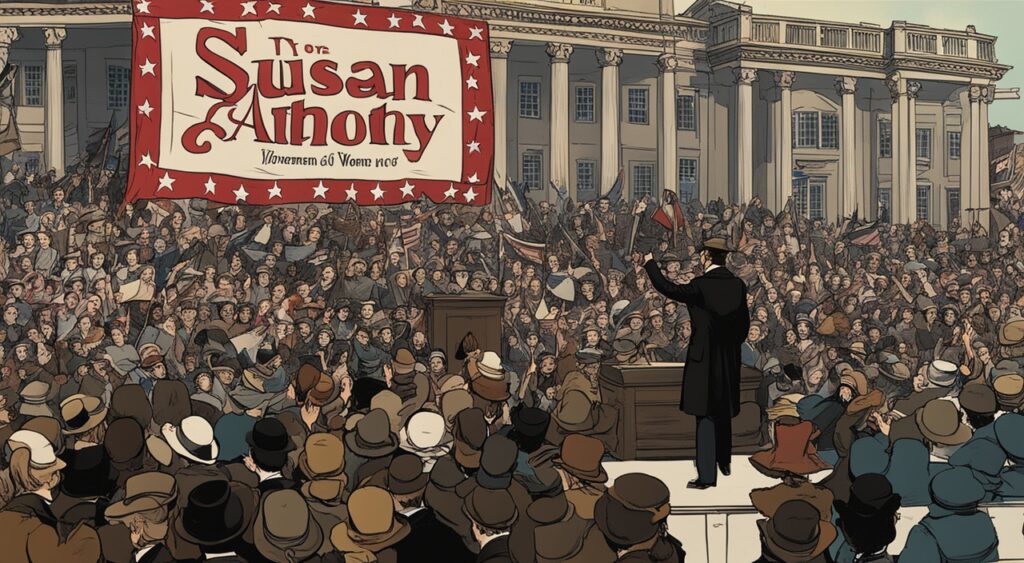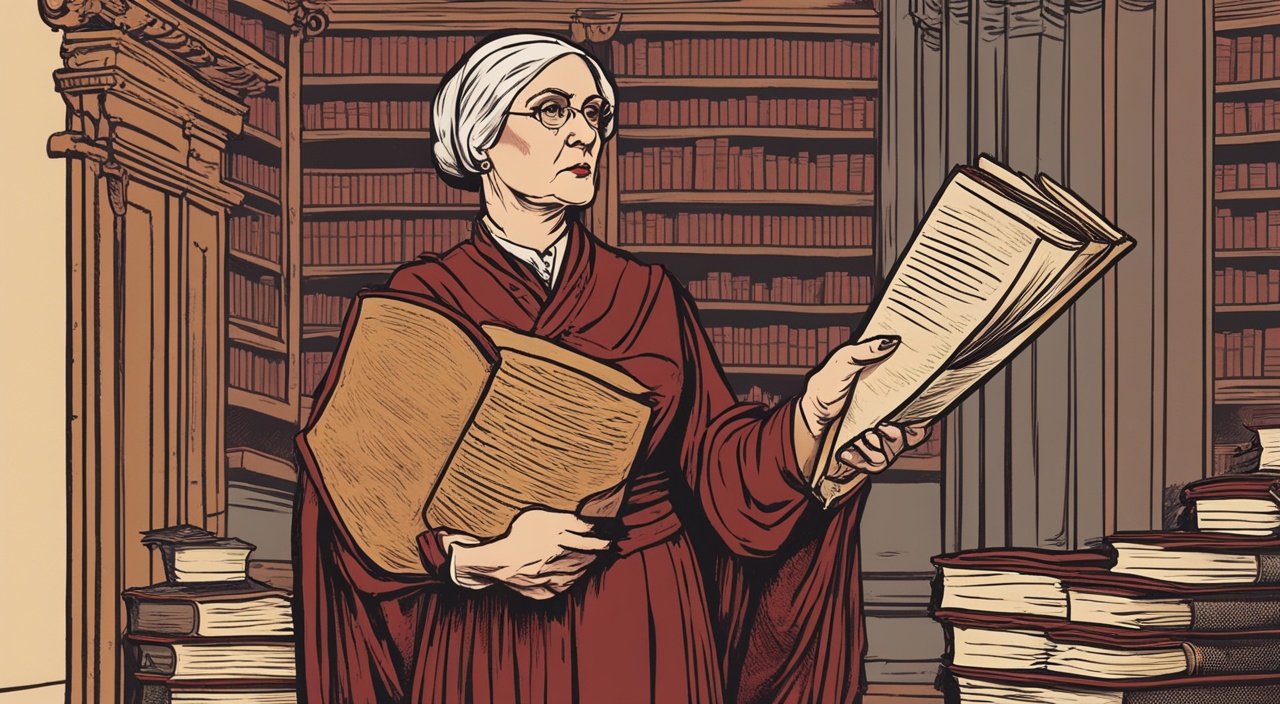More than 100 years ago, Susan B. Anthony changed the game for women’s rights in the USA. She was born on February 15, 1820, in Adams, Massachusetts. Anthony fought hard for women to have the right to vote, making history.
Anthony and her friend, Elizabeth Cady Stanton, were unstoppable. They made the National Woman Suffrage Association in 1869. This group pushed for the 19th Amendment until it was signed into law in 1920. Then, all American women could finally vote.
Key Takeaways
- Susan B. Anthony was a pioneering crusader for women’s rights and the women’s suffrage movement in the United States.
- She served as the president of the National Woman Suffrage Association from 1892 to 1900, helping pave the way for the passage of the 19th Amendment.
- Anthony was a tireless advocate for temperance, abolition, and labor rights, in addition to her work in the women’s suffrage movement.
- She traveled the country, delivering passionate speeches in favor of women’s suffrage and becoming one of the most visible leaders of the movement.
- Anthony’s contributions to women’s rights were commemorated with her image becoming the first woman depicted on a U.S. coin in 1979.
Early Life and Quaker Upbringing
Susan B. Anthony was born in Adams, Massachusetts, on February 15, 1820. She grew up in a Quaker family with strong beliefs in equality. Her father ran a cotton mill, and her mother’s family fought in the American Revolution. Anthony was deeply influenced by the Quaker faith’s principle of equality for all.
Born into a Family of Activists
Anthony was the second of eight children. Only five of the children reached adulthood. Her family was deeply involved in the abolitionist movement and temperance movement. This early exposure to social issues fueled her dedication to fighting for equality for everyone.
Formative Years Shaped by Equality Beliefs
Living in a Quaker home, Anthony learned about equality early on. In Rochester, New York, her family’s farmhouse was a hub for abolitionists. This setting influenced her greatly, guiding her towards a life of advocating for women’s rights and the end of slavery.
“Failure is impossible.”
Susan B. Anthony Biography
Susan B. Anthony was a leading force for women’s rights in the U.S. After teaching for a while, she returned to New York. There, she met famous people fighting against slavery and for women’s rights. For example, she crossed paths with William Lloyd Garrison and Frederick Douglass. They motivated her to join the fight for abolishing slavery and pushing for women’s right to vote.
Back then, it wasn’t common for women to speak in public. But Susan Anthony went against the norm and became an outspoken abolitionist. 1848 was special. It saw the gathering at Seneca Falls, where the women’s suffrage movement took its first steps. Even if she wasn’t there, she met Elizabeth Cady Stanton not long after. Together, they battled for over half a century to win women’s rights.
Lifelong, from 1820 to 1906, Susan was devoted to the cause. Her hard work spanned over fifty years. Born in Massachusetts and passing in 1906, she witnessed the start of women’s power at the polls. But she didn’t see the day all women gained that right in 1920. The 19th Amendment became law, allowing only white women to vote. This happened 14 years after Anthony’s death.
Even with all her efforts, Susan Anthony faced challenges. She never had a chance to legally vote. In 1872, she fought the law but was fined for casting a ballot illegally. It didn’t stop her. Showing amazing resilience, she got to present a new change to the Constitution in 1878.
Anthony’s work made a big mark. In 1979, the U.S. honored her by putting her on the silver dollar. This action shouts loudly about her historical role as a pioneer for women’s rights.
“Failure is impossible.”
– Susan B. Anthony
| Key Facts about Susan B. Anthony |
|---|
| Born: February 15, 1820, in Adams, Massachusetts |
| Died: March 13, 1906, in Rochester, New York |
| Never legally got to vote |
| Arrested and fined $100 for illegally voting in 1872 |
| First woman featured on a U.S. coin (silver dollar) in 1979 |
| Worked for over 50 years to advance the women’s suffrage movement |
| Died 14 years before the 19th Amendment granted women the right to vote |
Abolition and Temperance Movements
Susan B. Anthony was deeply involved in the abolition and temperance fights. She worked with top abolitionists to bring change. By 1856, Anthony was promoting the end of slavery, holding meetings, giving talks, and spreading the word. She also pushed for better jobs in her paper, The Revolution, asking for an eight-hour workday and fair pay for everyone when it launched in 1868.
Joining Forces with Leading Abolitionists
Anthony teamed up with big abolition names like Frederick Douglass and William Lloyd Garrison. Together, they made a big impact. In 1852, being turned down to speak at a temperance event in Albany drove Anthony to help start the Woman’s New York State Temperance Society. With Elizabeth Cady Stanton, it was an early win and pushed them further into the fight for voting rights.
| Abolition Activism | Temperance Movement |
|---|---|
|
|
Susan B. Anthony was a strong voice for ending slavery and banning alcohol. Her work with abolitionists and in temperance made her see that women must vote to make a real change. This belief led her to fight hard for women’s right to vote.
Women’s Suffrage Advocacy
Susan B. Anthony worked hard for women’s right to vote. She started the American Equal Rights Association in 1866 with Elizabeth Cady Stanton. They fought for equality. But African American men got the right to vote first. Anthony and Stanton then fought even harder.
Founding the National Woman Suffrage Association
In 1869, Anthony and Stanton started the National Woman Suffrage Association. They wanted a new law to let women vote. They traveled a lot, talking and raising money. People loved Anthony’s inspiring talks about suffrage.
Speeches, Activism, and Arrest for Voting
Anthony caused a stir in 1872 when she voted illegally. She got a big fine but refused to pay. Her arrest helped the suffrage movement grow. The 19th Amendment gave women the right to vote in 1920.
“Cautious, careful people, always casting about to preserve their reputation and social standing, never can bring about a reform. Those who are really in earnest must be willing to be anything or nothing in the world’s estimation, and publicly and privately, in season and out, avow their sympathy with despised and persecuted ideas and their advocates, and bear the consequences.”
– Susan B. Anthony
Anthony’s passion for suffrage was very strong, even after her arrest and bad press. She inspired many to support the cause. Thanks to her and other activists, the 19th Amendment was passed. This Amendment is also known as the “Susan B. Anthony Amendment,” honoring her work.

Leadership and Partnership with Elizabeth Cady Stanton
Susan B. Anthony and Elizabeth Cady Stanton worked together for over 50 years. They co-started the American Equal Rights Association. They also ran The Revolution, a newspaper that fought for women’s rights. They gave talks all over, supporting the women’s suffrage movement.
The Revolution and Women’s Rights Newspaper
In 1868, Anthony and Stanton launched The Revolution. It was a bold newspaper about women’s rights. The paper talked about voting rights, owning property, work, and laws about divorce.
Working together, Anthony and Stanton made The Revolution powerful. Stanton managed the paper. Anthony made sure it ran smoothly and found money. They both used the paper to push for women’s rights and change society’s view on women.
The newspaper was key in their work for women to vote. It let them talk to many people and gain support. The Revolution was also a place where other activists and thinkers could share their views on women’s rights.
“Failure is impossible.” – Susan B. Anthony
Anthony and Stanton faced many obstacles but stayed true to their cause. Their teamwork and leadership were key. They helped make sure the 19th Amendment was passed, allowing women to vote.
Susan B. Anthony’s relentless fight for women’s suffrage paved the way for future generations of female leaders, including Meryl Streep [Meryl Streep Biography], who uses her platform to advocate for feminist causes.
Legacy and Lasting Impact
Susan B. Anthony was deeply committed to women’s rights. She made a big difference in our country’s history. Though she died before women could vote, her work was key to the 19th Amendment’s success in 1920. This amendment allowed women to vote and was called the “Susan B. Anthony Amendment” for her.
In 1979, she made history again. She was the first woman on a U.S. coin, the Susan B. Anthony dollar. This honored her ongoing efforts for women’s rights and equality. Even though Anthony passed away in 1906, she is remembered for her strong will, bravery, and her fight for justice.
Susan B. Anthony’s tale still moves people today. It motivates both women and men to work for women’s rights in society. Her efforts and the 19th Amendment have opened new paths for women in the U.S. They show that the fight for gender equality must go on.
FAQ
Who was Susan B. Anthony?
Susan B. Anthony was an American activist. She was a leader in the women’s suffrage movement. As the president of the National Woman Suffrage Association from 1892 to 1900, she laid the groundwork for the 19th Amendment. This amendment granted women the right to vote in 1920.
What were some of Susan B. Anthony’s key achievements?
Anthony backed temperance, abolition, and labor rights. She was a known figure in the women’s suffrage movement. Her passionate speeches across the nation greatly influenced the later passing of the 19th Amendment.
How did Susan B. Anthony’s Quaker upbringing shape her activism?
Anthony’s early influence was the Quaker idea that everyone is equal under God. Many of her siblings were also activists. They stood for justice and freedom, fueling her dedication to change.
How did Susan B. Anthony’s partnership with Elizabeth Cady Stanton impact the women’s suffrage movement?
Anthony and Stanton formed the American Equal Rights Association in 1866. They later took charge of its newspaper, The Revolution, to promote women’s rights. Together, they spoke across the country in support of women’s suffrage.
What was Susan B. Anthony’s role in the abolition and temperance movements?
Anthony was against slavery and deeply involved in abolitionism. Although frowned upon, she spoke publicly against these issues. She was also passionate about temperance, leading to the formation of the Woman’s New York State Temperance Society in 1852.
How did Susan B. Anthony’s arrest for voting impact the women’s suffrage movement?
In 1872, Anthony was arrested for voting illegally. The media attention boosted the suffrage cause. This made her more determined to secure women’s rights through a constitutional amendment.
What is Susan B. Anthony’s lasting legacy?
Anthony’s work was pivotal in the 19th Amendment’s eventual passage. Even after her time, she is remembered as crucial to the suffrage movement’s triumph. Her legacy is recognized through the “Susan B. Anthony Amendment” and appearing on a U.S. coin since 1979.
